Family : Haemulidae

Text © Giuseppe Mazza

English translation by Mario Beltramini
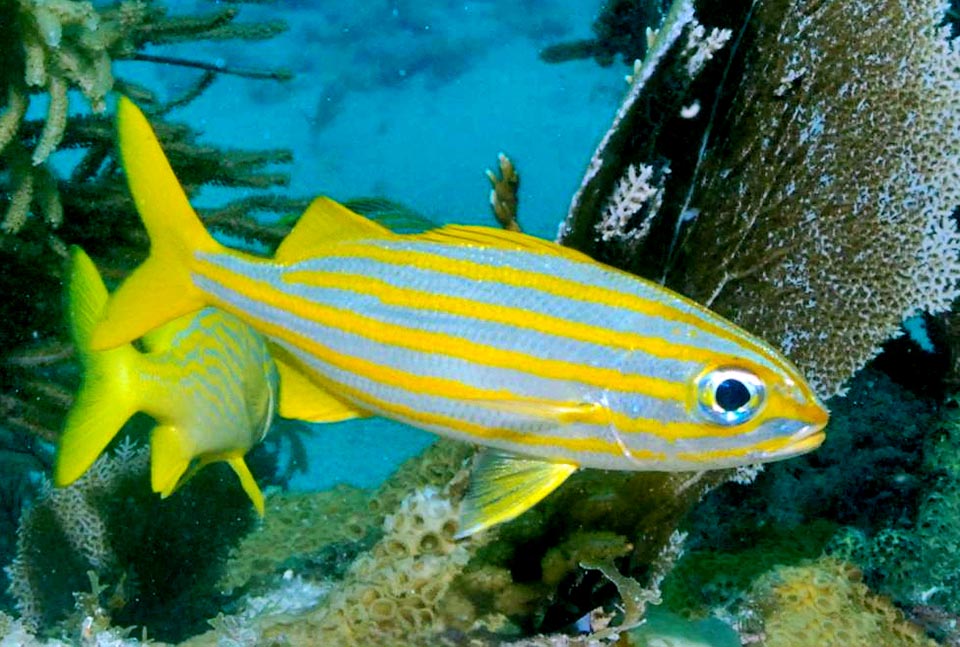
At times mixed with other species of Haemulidae, Brachtgenys chrysargyreum is very common in west Atlantic, from south of Florida to Antilles and Brazil © Graham Edgar, Reef Life Survey
The Smallmouth grunt, Brachygenys chrysargyreum (Günther,1859), belongs to the class of the Actinopterygii, the ray-finned fishes, to the order Perciformes and to the family of the Haemulidae, almost exclusively present in marine and brackish waters that nowadays counts 23 genera and 135 species. Fishes that rarely exceed 60 cm in length, often present thanks to their glittering beauty in the big public aquaria, and that recall at first sight due to their look the Sparidae or the Sciaenidae sometimes covering an important rôle in the human diet.
The name of the genus Brachygenys comes from the Greek “βραχυζ” (Brachy), short and “ϒενυζ” (genys), chin, with reference, as indicated anyway by the common name, to the small mouth, whilst the vulgar term of Grunt, term taken up in various languages, reminds, like for Anisotremus virginicus, the sound this fishes do using the swim bladder as sounding box while they grind their numerous small pharyngeal teeth.
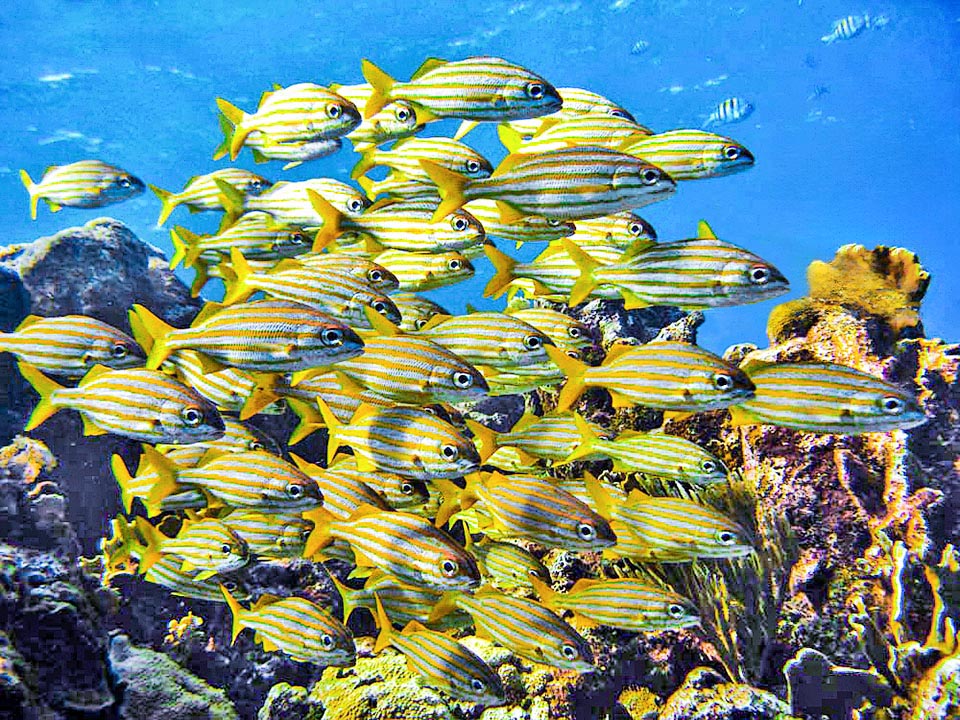
During the day it rests in plain sight, socially camouflaged in motionless schools, that thanks to the particular striped livery do not attract the attention of the predators © Mickey Charteris
The specific term chrysargyreum gets its origin always from the Greek “χρυσός” (chrysos), gold, and from “ἄργῠρος” (árgyros), silver, with reference to the alternation of the golden and silvery bands of its glittering livery.
Zoogeography
Brachygenys chrysargyreum is a species common in the tropical waters of western Atlantic, from south Florida to the Antilles and to Brazil.
Ecology-Habitat
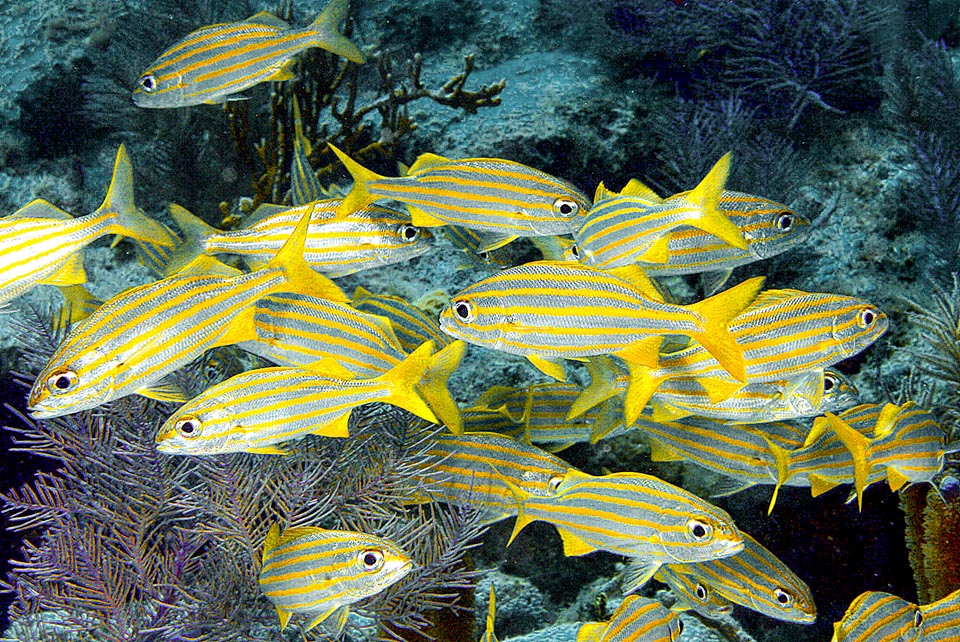
Measures mainly 17 cm and apart some specimens ending up in the public aquaria, is an uninteresting fish that is consumed locally © Kevin Bryant
It lives in relatively shallow waters, up to about 20-25 m of depth. During the day it often rests in dense schools, almost motionless, over the madreporic formations. About this it has been talked of as “social mimicry” because, grouping together with their parallel lined liveries they create a shapeless mass that confuses the predators.
Then, by evening, the group gets animated and the fishes disperse to feed in the open sea of plankton, small crustaceans and mollusks.
Conversely, the juveniles grow hiding among the leaves of Thalassia testudinum, a phanerogam forming large expanses in the Gulf of Mexico and in the Caribbean Sea, known as Turtlegrass because in addition to offering hiding places and a rich pasture to the herbivorous fishes is very appreciated by these big reptiles.
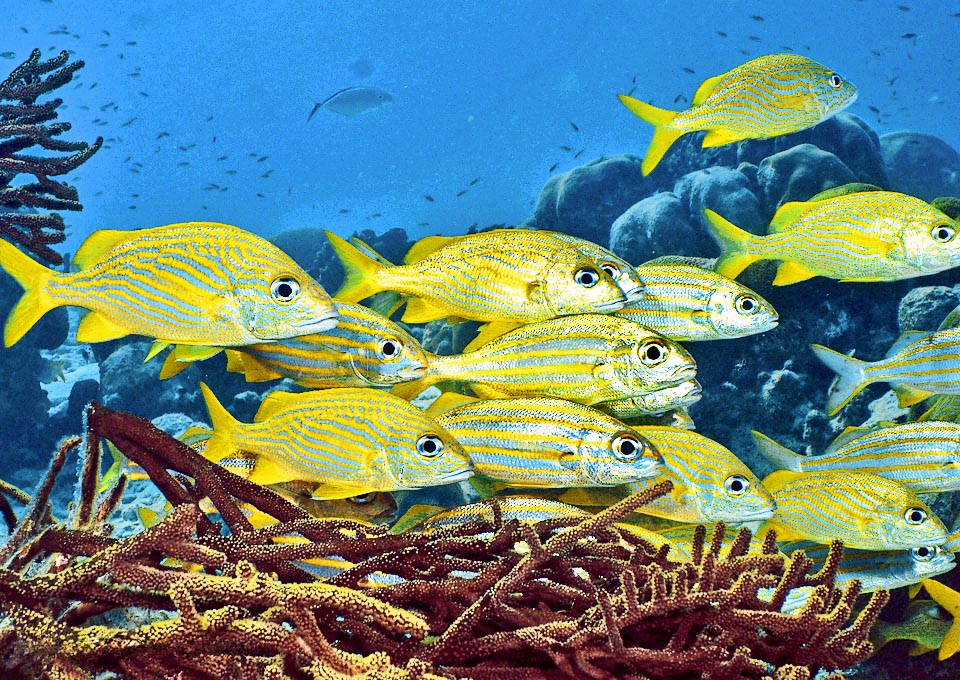
Here it rests mixed to specimens of Haemulon flavolineatum, species of the same family with similar colours but with different drawing © Pauline Walsh Jacobson
Morphophysiology
Brachygenys chrysargyreum can reach the length of 23 cm even if the size of the catch is around 17 cm.
The oblong, cylindrical body has a decidedly short snout, with the jaw that does not even reach, vertically, the anterior edge of the pupil, and among the Haemulidae it’s the one having the smallest mouth with however the interior lined in red although not very visible.
The dorsal fin has 12 spiny rays, often folded, and 13 unarmed, whilst the anal counts 3 spines and 9-10 soft rays.
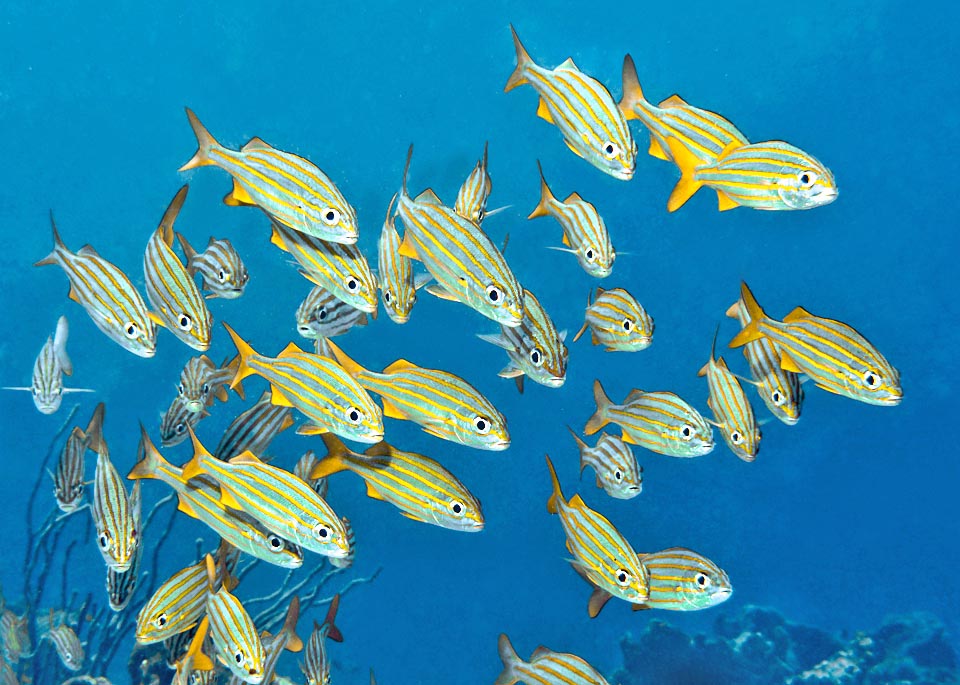
By evening the mimetic group animates and the fishes disperse to eat in open sea zooplankton, small crustaceans and mollusks © Pauline Walsh Jacobson
The pectoral fins are unarmed with 15-17 rays and the caudal one is forked.
The livery of the adults is characterized by 5 yellow longitudinal stripes that stand out on the silvery sides, plus one more, less wide, on the back, that starts at level of the eyes and continues up to the caudal fin, equally yellow like all the fins but the pectoral ones.
Conversely, the juveniles display 3 brown stripes on the upper part of the body. The most marked starts from the snout, crosses the eye camouflaging it and ends on the caudal peduncle where is present a showy black spot with white edge that forms a false eye to fool the predators by directing them towards the decidedly less vital zone of the head. Are not yet noticeable showy traces of yellow on the body or on the fins.
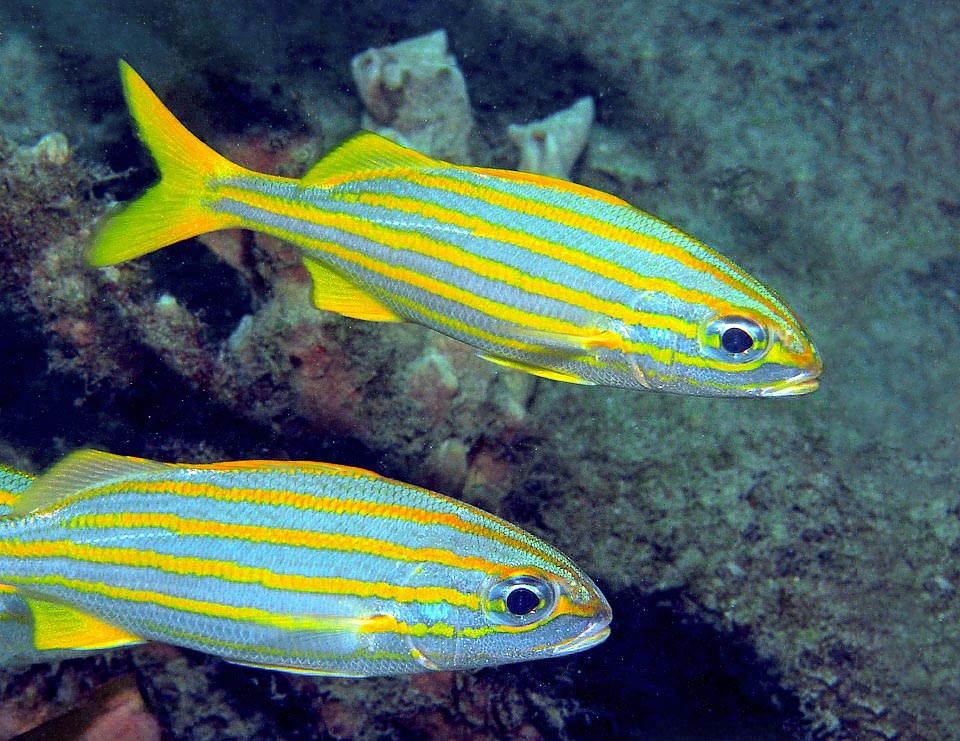
The reproduction of Haemulon flavolineatum does not occur in groups, but in pairs in the open sea with eggs entrusted to the currents © Pauline Walsh Jacobson
Ethology-Reproductive Biology
In the daytime camouflage gatherings of Brachygenys chrysargyreum we often note, mixed together, fishes of similar size such as Haemulon sciurus, Haemulon aurolineatum, Haemulon flavolineatum, Haemulon parra or Anisotremus virginicus belonging to the same family.
The reproduction does not occur, as we might think, in groups, but in couples in the open sea with eggs entrusted to the currents.
Although abundant along the coasts, given the modest size, the fishing of the Smallmouth grunt remains predominantly local and destined for local consumption, apart from some minor catches for the large public aquaria.
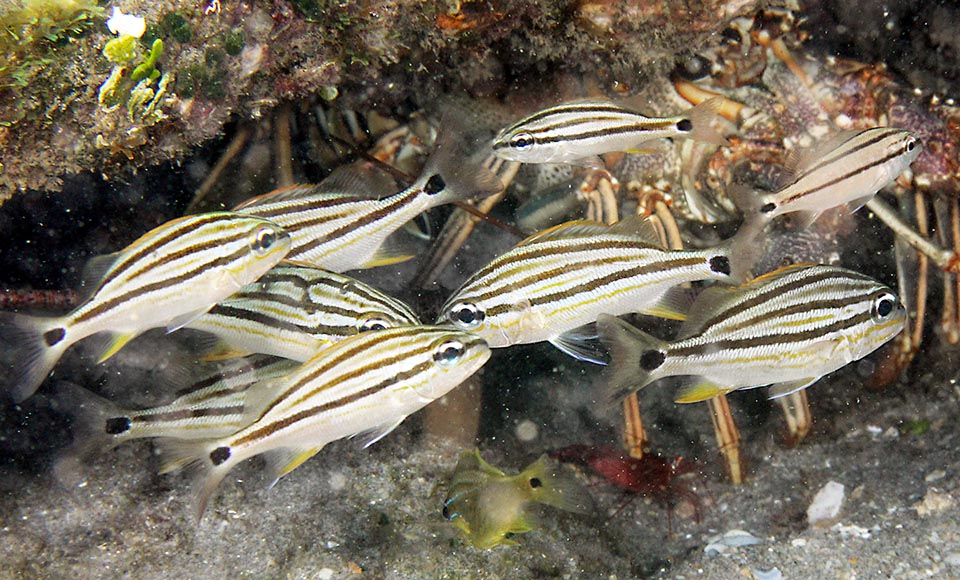
Juveniles have 3 dark bands on upper part of body. The biggest hides the eye and on the caudal peduncle a black spot with white edge creates a false one © Kevin Bryant
The resilience of this species is decidedly high, with populations that can double, theoretically, their members decimated by the events, in less than 15 months.
The fishing vulnerability, low, marks only 13 on a scale of 100, and Brachygenys chrysargyreum appears consequently as “LC, Least Concern”, that is at minimal risk, in the IUCN Red List of the endangered species.
Synonyms
Haemulon chrysargyreum Günther, 1859; Pristipoma serrula Cuvier, 1830; Haemulon taeniatum Poey, 1860; Brachygenys taeniata (Poey, 1860).
→ For general information about FISH please click here.
→ For general information about BONY FISH please click here
→ For general information about CARTILAGINOUS FISH please click here.
→ To appreciate the BIODIVERSITY of BONY FISH please click here.
→ To appreciate the BIODIVERSITY of CARTILAGINOUS FISH please click here.
